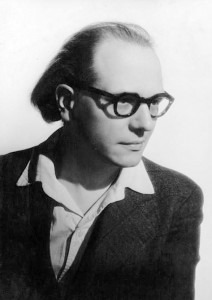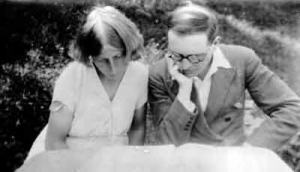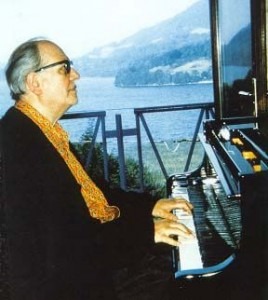
Olivier Messiaen in 1930
His Poèmes pour Mi were written for his beloved wife Claire Delbos. She was a violinist and a composer and they married in 1932. He wrote works for her to play and he wrote pieces about their love. ‘Mi’ was his nickname for Claire and these songs are his hymn to their love. Messiaen was both poet and composer for these songs.
The titles reflect all kinds of emotions – from the calm of Thanksgiving to the horrors of Terror but ends with a final prayer.
Book 1: No. 1. Action de grâces (Thanksgiving)
Book 1: No. 2. Paysage (Landscape)
Book 1: No. 3. La maison (The House)
Book 1: No. 4. Épouvante (Terror)
Book 2: No. 5. L’épouse (The Bride)
Book 2: No. 6. Ta voix (Your Voice)
Book 2: No. 7. Les deux guerriers (The Two Warriors)
Book 2: No. 8. Le collier (The Necklace)
Book 2: No. 9. Prière exaucée (Prayer Answered)
The opening song sets the stage for the work, beginning with the jewel-like piano opening and its prayer-like vocals. The tension grows within the piece and it seems to end abruptly.
Messiaen: Poèmes pour Mi: Book 1: No. 1. Action de grâces (Phyllis Bryn-Julson, soprano; Mark Markham, piano)

Olivier Messiaen and Claire Delbos
Messiaen: Poèmes pour Mi: Book 1: No. 3. La maison
The next song is quite shocking: No. 4. Terror. This is the fear of the composer made into music. Memories intrude and follow him into darkness – his despair only makes the fear grow.
Messiaen: Poèmes pour Mi: Book 1: No. 4. Épouvante
His fears are assuaged, however, by the next song The Bride. The poem takes the language of the wedding ceremony as its theme: ‘Nul ne peut séparer ce que Dieu a uni’ (No one will separate what God has united). He makes the analogy that just as the church is the extension of Christ, the wife is the extension of the husband.
Messiaen: Poèmes pour Mi: Book 1: Book 2: No. 5. L’épouse

Messiaen’s house in Petichet with the composer at the keyboard
The set closes with a similar chant-like opening that we heard in the opening song. Claire is his answered prayer and the whole cycle closes with ‘La joie est revenue.,’ (The joy is back).
Messiaen: Poèmes pour Mi: Book 2: No. 9. Prière exaucée
Olivier and Claire had a child in 1937 and the composer celebrated the birth of their son Pascal with the song cycle Chants de terre et de ciel in 1938. After an operation towards the end of WWII, Claire began to suffer from loss of memory and was confined to a sanatorium for the rest of her life. She died in 1959. Messiaen married the pianist Yvonne Loriod in 1961, whom he’d known since 1943.


